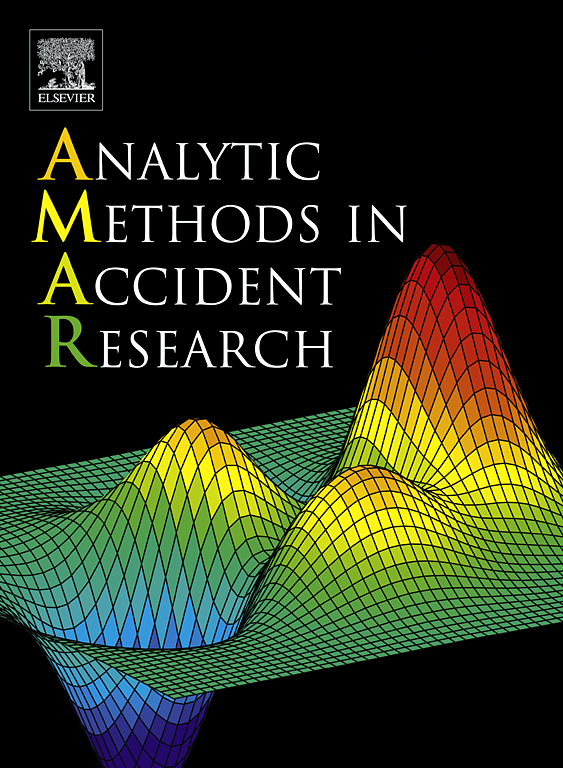Exploring the dynamic determinants of general aviation accidents across flight phases and time: A random parameter bivariate probit approach with heterogeneity in means
IF 12.6
1区 工程技术
Q1 PUBLIC, ENVIRONMENTAL & OCCUPATIONAL HEALTH
引用次数: 0
Abstract
General aviation experiences significant variation in accident characteristics across flight phases. This study seeks to investigate the phase transferability and temporal stability of determinants influencing general aviation accidents, using the U.S. data (2008–2019) from the National Transportation Safety Board. To achieve this, a random parameter bivariate approach with heterogeneity in means was employed, focusing on two binary outcomes: injury severity (fatal/severe vs. minor/none) and aircraft damage (destroyed vs. non-destroyed). Four flight phases were analyzed: departure, enroute, maneuvering, and arrival. The data were divided into three time periods, 2008–2011, 2012–2015, and 2016–2019, to assess the determinants’ temporal stability. Likelihood ratio tests revealed that pilot injury and aircraft damage risks exhibit phase non-transferability and temporal instability. Out-of-sample predictions indicated a steady rise in fatal or severe injury risk, while aircraft damage risk initially increased before declining over time. A significant positive correlation between pilot injury and aircraft damage was observed through model estimation. Key factors, including pilot, aircraft, flight, and environmental conditions, significantly influenced both outcomes. Moreover, factors such as decision-making errors, adverse physiological conditions, fixed landing gear, and visual meteorological conditions showed both phase transferability and temporal stability. However, most factors were phase- and period-specific. Based on these findings, targeted measures, such as pilot escape and survival training, as well as phase-specific, scenario-based training, are proposed to mitigate general aviation risks.
探索跨飞行阶段和时间的通用航空事故的动态决定因素:一种随机参数双变量概率方法
通用航空在不同飞行阶段的事故特征有显著差异。本研究旨在利用美国国家运输安全委员会(National Transportation Safety Board) 2008-2019年的数据,调查影响通用航空事故的决定因素的相位可转移性和时间稳定性。为了实现这一目标,采用了随机参数双变量方法,方法具有异质性,重点关注两个二元结果:损伤严重程度(致命/严重vs.轻微/无)和飞机损伤(损坏vs.未损坏)。分析了四个飞行阶段:起飞、途中、机动和到达。数据分为2008-2011年、2012-2015年和2016-2019年三个时间段,以评估影响因素的时间稳定性。似然比测试显示,飞行员受伤和飞机损坏风险表现出阶段不可转移性和时间不稳定性。样本外的预测表明,致命或严重伤害的风险稳步上升,而飞机损坏的风险最初是上升的,然后随着时间的推移而下降。通过模型估计,发现飞行员损伤与飞机损伤之间存在显著的正相关关系。包括飞行员、飞机、飞行和环境条件在内的关键因素对两种结果都有显著影响。此外,决策失误、不利生理条件、固定起落架和目视气象条件等因素均表现出相转移性和时间稳定性。然而,大多数因素是特定阶段和特定时期的。基于这些发现,提出了有针对性的措施,如飞行员逃生和生存培训,以及分阶段、基于场景的培训,以降低通用航空风险。
本文章由计算机程序翻译,如有差异,请以英文原文为准。
求助全文
约1分钟内获得全文
求助全文
来源期刊

Analytic Methods in Accident Research
Multiple-
CiteScore
22.10
自引率
34.10%
发文量
35
审稿时长
24 days
期刊介绍:
Analytic Methods in Accident Research is a journal that publishes articles related to the development and application of advanced statistical and econometric methods in studying vehicle crashes and other accidents. The journal aims to demonstrate how these innovative approaches can provide new insights into the factors influencing the occurrence and severity of accidents, thereby offering guidance for implementing appropriate preventive measures. While the journal primarily focuses on the analytic approach, it also accepts articles covering various aspects of transportation safety (such as road, pedestrian, air, rail, and water safety), construction safety, and other areas where human behavior, machine failures, or system failures lead to property damage or bodily harm.
 求助内容:
求助内容: 应助结果提醒方式:
应助结果提醒方式:


